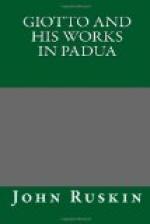The chapel having been founded, as stated above, in 1303, Giotto appears to have been summoned to decorate its interior walls about the year 1306,—summoned, as being at that time the acknowledged master of painting in Italy. By what steps he had risen to this unquestioned eminence it is difficult to trace; for the records of his life, strictly examined, and freed from the verbiage and conjecture of artistical history, nearly reduce themselves to a list of the cities of Italy where he painted, and to a few anecdotes, of little meaning in themselves, and doubly pointless in the fact of most of them being inheritances of the whole race of painters, and related successively of all in whose biographies the public have deigned to take an interest. There is even question as to the date of his birth; Vasari stating him to have been born in 1276, while Baldinucci, on the internal evidence derived from Vasari’s own narrative, throws the date back ten years.[3] I believe, however, that Vasari is most probably accurate in his first main statement; and that his errors, always numerous, are in the subsequent and minor particulars. It is at least undoubted truth that Giotto was born, and passed the years of childhood, at Vespignano, about fourteen miles north of Florence, on the road to Bologna. Few travellers can forget the peculiar landscape of that district of the Apennine. As they ascend the hill which rises from Florence to the lowest break in the ridge of Fiesole, they pass continually beneath the walls of villas bright in perfect luxury, and beside cypress-hedges, enclosing fair terraced gardens, where the masses of oleander and magnolia, motionless as leaves in a picture, inlay alternately upon the blue sky their branching lightness of pale rose-colour, and deep green breadth of shade, studded with balls of budding silver, and showing at intervals through their framework of rich leaf and rubied flower, the far-away bends of the Arno beneath its slopes of olive, and the purple peaks of the Carrara mountains, tossing themselves against the western distance, where the streaks of motionless cloud burn above the Pisan sea. The traveller passes the Fiesolan ridge, and all is changed. The country is on a sudden lonely. Here and there indeed are seen the scattered houses of a farm grouped gracefully upon the hill-sides,—here and there a fragment of tower upon a distant rock; but neither gardens, nor flowers, nor glittering palace-walls, only a grey extent of mountain-ground, tufted irregularly with ilex and olive: a scene not sublime, for its forms are subdued and low; not desolate, for its valleys are full of sown fields and tended pastures; not rich nor lovely, but sunburnt and sorrowful; becoming wilder every instant as the road winds into its recesses, ascending still, until the higher woods, now partly oak and partly pine, drooping back from the central crest of the Apennine, leave a pastoral wilderness of scathed rock and arid grass, withered away here




